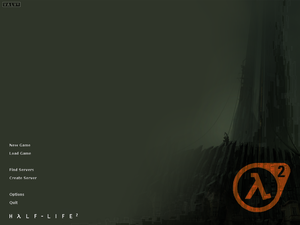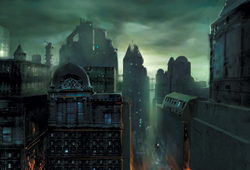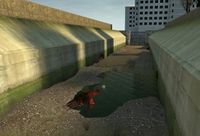Development of Half-Life 2
See our disclaimer about the leaked material. |
| The contents of this article have been cut. | ||
|---|---|---|
The subject matter of this article contains in-development information that was cut from the final version of an official and/or canonical source and appears in no other canonical source. It may also contain incomplete information since not all cut material is publicly known. |
This article is a stub. Maybe you can help by expanding it. |
|---|
| Warning! This article has yet to be cleaned up to a higher standard of quality, per our Cleanup Project. It may contain factual errors and nonsense, as well as spelling, grammar and structure issues, or simply structure problems. Reader's discretion is advised until fixing is done. | ||
|---|---|---|
You can help clean up this page by correcting spelling and grammar, removing factual errors and rewriting sections to ensure they are clear and concise, and moving some elements when appropriate. |
- "There is a lot of value in refinement. There's an aggressive statement of this principle, which isn't entirely true but it's still interesting: It doesn't matter what we cut, so long as we cut it and it gives us the time to focus on other things, because any of the options will be bad unless they're finished, and any of them will be good if they are finished."
- ― Gabe Newell[src]
The development of Half-Life 2 began almost immediately after the release of Half-Life, spanning from 1999 to the release of Half-Life 2 in 2004. During that elongated process, many things were outlined, created and cut before the game's final release.
Within the Half-Life community, this period is referred to under several names. They include:
- Development stage names, such as "Half-Life 2 Alpha", "Half-Life 2 Beta", or simply "Alpha" or "Beta". These terms, coined by the community and not Valve, are used incorrectly most of the time when referring to a particular subject of this period, as no development stages for any subject is known. Despite this, they are widely used across the community, as they are commonly used in the general gaming community to refer to any early stages of a video game. Therefore they should be taken as placeholder names referring to large periods of a game's development, "Alpha" being used for the early stages, "Beta" for the last stages that precede the retail release).
- The "Half-Life 2 leak" (or simply "the leak"), when referring to the material stolen (or "leaked") from Valve in 2003 by German hacker Axel Gembe, including source code, about 1300 maps, and a playable game (referred to by Gembe as "Chosen 9"). These files of course include anything referred to by the community as "Alpha" or "Beta". Valve does not refer to it as a leak but as a theft.[1]
- All in all the correct terms are "Half-Life 2 leak" or the "playable Half-Life 2 leak" for the stolen content. When referring to early elements of Half-Life 2, the terms "early Half-Life 2 build" or "early version of Half-Life 2" would be more appropriate, as well as, for instance, "the early City 17" or "the early Breencast". "Alpha" and "Beta" should never be used unless specifically stated. This also applies to any other development period of any other Valve game.
Contents
Original plot
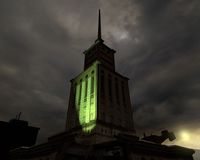
The book Half-Life 2: Raising the Bar and the numerous leaked files revealed many of the game's original settings and action that were either cut down or removed entirely from the final game. Half-Life 2 was originally intended to be a far darker game based on far grittier artwork where the Combine were more obviously draining the oceans for minerals and replacing the atmosphere with noxious, murky gases.
Half-Life 2 was also originally intended to be much more diverse in settings, and the original journey was extremely long (to the extent that the game felt almost overblown, with little time being spent on developing existing characters; one of the key reasons for it being cut). Several City 17 levels at the start of the game and complete chapters from the second half of the game were completely removed and sometimes re-introduced in the subsequent Half-Life 2 episodes.
Parts of the book Half-Life 2: Raising the Bar and the leaked files detail how Gordon would fight alongside characters such as Odell in the Borealis, as well as fighting together with Captain Vance and Vance's forces, the Conscripts, in the Air Exchange, the Weather Control and the rooftops of City 17. Originally, Eli and Alyx Vance had no relation, and Eli's lab was located in a cave in a scrapyard and was much rougher than the better equipped laboratory within a hydroelectric power station in the retail version (the scrapyard area where the Gravity Gun tutorial takes place, being an auxiliary area as opposed to the bulk of the lab, is reminiscent of the original concept). The Citadel also looked very different, it was more round than the bulky Citadel from the final version.
Style
While the playable game leaked in 2003 is quite similar to the retail product and already heavily trimmed, this earlier period of development of the game shows a quite different style. At this point, City 17 was an American East Coast-like city based on Washington, D.C.,[2] with many huge skyscrapers, and had a very basic, blocky FPS design.[3] It was more faithful to the concept art seen in Raising the Bar: darker, gothic, sinister, rainy, foggy, gritty, with a lot of brick, metal and glass, getting along well with the cut concept of the Combine replacing the air with poisonous gas and draining the oceans. It was therefore a much more dystopian, Orwellian universe (even though the final product is still quite Orwellian) even with touches of cyberpunk/steampunk style, in the vein of the book/film 1984 or other films such as Dark City, City of Lost Children, Avalon or Blade Runner. It was also more faithful to Viktor Antonov's early concept art and work on the game.
The Combine was rather using and recycling the existent human materials and buildings, instead of adding their own technology to them. This is why, for instance, the early Citadel had its walls covered with tiles.
During the time span leading to the 2003 leak, the team added more periods, such as the 30's, the 40's and the 70's, to finally get to a more Eastern post-Communist style we see in the retail version of the game, with older and smaller buildings, and a bright universe instead of a dark one, which is more in the vein of the original Half-Life. The Ravenholm levels are a reminiscence to the original style, even though the American East Coast-style skyscrapers were all removed.
Note that not all the concepts were not present in the development process at the same time, since the game had still a very rough, work-in-progress state.
Source code leak
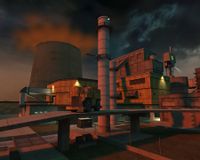
Half-Life 2 was merely a rumor until a strong impression at E3 in May 2003 launched it into high levels of hype, where it won several awards for best in show. It had a release date of September 2003, but was delayed. This pushing back of Half-Life 2's release date came in the wake of the cracking of Valve's internal network,[4] through a null session connection to Tangis which was hosted in Valve's network and a subsequent upload of an ASP shell. The hacker was also able to guess Gabe Newell's password, which was simply "gaben".
This culminated in the leak of the game's source code on the Internet on the 2nd of October, and a second leak containing the game itself five days later.[5] On the same day as the source code leak Valve CEO Gabe Newell publicly explained in the HalfLife2.net forums the events that Valve experienced around the time of the leak, and requested that users possessing relevant information assist Valve in tracking down the perpetrators:
"Ever have one of those weeks? This has just not been the best couple of days for me or for Valve.
Yes, the source code that has been posted is the HL-2 source code.
Here is what we know:
1) Starting around 9/11 of this year, someone other than me was accessing my email account. This has been determined by looking at traffic on our email server versus my travel schedule.
2) Shortly afterwards my machine started acting weird (right-clicking on executables would crash explorer). I was unable to find a virus or trojan on my machine, I reformatted my hard drive, and reinstalled.
3) For the next week, there appears to have been suspicious activity on my webmail account.
4) Around 9/19 someone made a copy of the HL-2 source tree.
5) At some point, keystroke recorders got installed on several machines at Valve. Our speculation is that these were done via a buffer overflow in Outlook's preview pane. This recorder is apparently a customized version of RemoteAnywhere created to infect Valve (at least it hasn't been seen anywhere else, and isn't detected by normal virus scanning tools).
6) Periodically for the last year we've been the subject of a variety of denial of service attacks targetted at our webservers and at Steam. We don't know if these are related or independent.
Well, this sucks.
What I'd appreciate is the assistance of the community in tracking this down. I have a special email address for people to send information to, helpvalve@valvesoftware.com. If you have information about the denial of service attacks or the infiltration of our network, please send the details. There are some pretty obvious places to start with the posts and records in IRC, so if you can point us in the right direction, that would be great.
We at Valve have always thought of ourselves as being part of a community, and I can't imagine a better group of people to help us take care of these problems than this community.
Gabe"
In June 2004, Valve announced in a press release that the FBI had arrested several people suspected of involvement in the source code leak.[6] Valve claimed the game had been leaked by a German black-hat hacker named Axel Gembe, aka 'Ago' or 'Chosen 9',[7] born c. 1982. Gembe later contacted Newell through e-mail (also providing an unreleased document planning the E3 events). Gembe was led into believing that Valve wanted to employ him as an in-house security auditor. He was to be offered a flight to the USA and was to be arrested on arrival by the FBI. When the German government became aware of the plan, Gembe was arrested in Germany instead, and put on trial for the leak as well as other computer crimes in November 2006, such as the creation of Agobot, a highly successful trojan which harvested users' data.[8][9][10]
At the trial in November 2006 in Germany, Gembe was sentenced to two years' probation. In imposing the sentence, the judge took into account such factors as Gembe's difficult childhood and the fact that he was taking steps to improve his situation.[11]
Although Valve has never made any official statement about how the leaked files should be considered and used by the community, no actions have been taken against websites or people using and hosting leak-related content, and Valve sanctioned websites such as Garry's Mod host many leak related material and discussing it is not forbidden on the website's Facepunch forums (which was forbidden in the past). The general consensus would then be that Valve is not preoccupied anymore by the use of these leaked files and their use and distribution is not forbidden although not blessed, as long as they are used for free; when asked to Valve by e-mail on July 20, 2009 about the status of the Beta-based mod Missing Information, the answer was that "the mod is not illegal to download and play as long as it is just a mod."
Leaked files
Playable game
The files leaked in 2003 consist in a playable game available in two versions, the "anon-hl2" leak and the "Russian" leak, which are slightly different. The "Russian" copy of the leak is, of course, based upon the original 100 part leak "anon-hl2". One of the few notable differences between the two is the presence of an installer, while the "anon-hl2" leak consists of 100 rar files. The "anon-hl2" beta contains at its root a .txt file last edited in October 2003, with these words:
"Just create a server to play.
in the console, use "noclip" when it's stuck.
Really full of bugs, sure that valve won't release it before a while.
Have fun !!!"
The work-in-progress nature of the game makes it obviously very incomplete and quite unstable, and some maps won't load. At this time, chapters like the Air Exchange, the Borealis, or the Skyscraper were already cut, and City 17 already had its Central/Eastern European style, making this game very similar to the retail product and representing what Half-Life 2 looked like in 2003. Therefore, the cuts were not made because of the leak, but for other reasons, and much earlier in the development process.
Features from the playable game
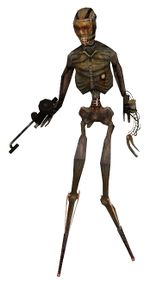
- The interface appears to be based off of the Steam version of the first Half-Life. For example, it has "Software", "OpenGL", and "DirectX" listed as usable renders in the "Video" tab, but the Source engine used DirectX only when it was released.
- There is extremely basic multiplayer support. It can support very few players. Interestingly, one of the tabs in the "Create a server" option is named "CPU Players".
- The game treats each single-player session like multiplayer; there is a scoreboard that can be brought up with TAB, and the player can type messages. If the player wants to follow the storyline, they have to access the map through the console, otherwise the next map will not load. It is however quite difficult to follow the incomplete storyline, and several maps won't load and crash the game.
- There is basic DirectX6 support, which consists of a few low-poly character models and a DirectX6 version of one of the Coast maps.
- The engine is of course less optimized than the one used by the final game.
- There is no built-in anti-aliasing. It can however be achieved with most recent graphic cards that override the games settings.
- The source code contains a folder called 'ivp' (IVP stands for Ipion Virtual Physics, a physics engine from Ipion Software that was bought out and brought into Havok 1) which contains Source's original physics engine from early 2001 containing IVP code (dating from 1999–2000) incorporated into the Havok code. The VPhysics engine based off Havok 2 is also present in a separate folder and is the final version retained in the Source engine.
- The game uses a unique ammo system not seen in the final version. Ammo is broken up into three types; small, medium, and heavy. The SMG2 uses small; the Pistol, SMG1, AR1 and OICW use medium; the HMG uses heavy.
- The .357 Magnum and Crossbow were not implemented in the game at the time of the leak, and as a result, do not exist in the playable prototype.
- Several sound files from chapters already cut in the playable version can still be found in the sound folders, such as early Breencast clips by the Consul, Conscripts dialog involving an Overwatch Sniper, Overwatch Soldiers chatting in the Skyscraper, a scripted sequence involving three homeless Citizens (nicknamed "hobos") talking about Vienna sausages, sounds from the E3 demonstrations, dialogs and music from the film Aliens, to be used for lip sync tests in the map "
testroom_ripley" (the dialogues) and the surreal map "ickypop" (the music), etc.[3][12]
WC mappack
Other files consisted in a group of several zip files nicknamed "WC mappack" (WC stands for Worldcraft, the early name for Hammer, the level editor), containing around 1300 incomplete VMF maps (VMF stands for "Valve Map File") of the very early chapters already cut in the playable game mentioned above (most of them are repeated and almost identical), demo/prototype maps and the maps from the playable version, spread in around 60 folders named by the developers who worked on them, and making up around 3 gigabytes. These maps can be opened in Hammer and can be run in any Half-Life game after texture fixing (since several textures can be missing, especially the original Combine metal variations) and compiling into BSP maps (using the option "Create a Mod" in the SDK and putting the textures from the playable leak in its folder will do most of the preliminary work, as most of the textures will be missing if the compiled map is played on a released game). The maps still have the date they were last modified, which can give other clues about the game development. Most of the maps are very old and were last edited/created in 2001 or 2002.
The leaked files available on the Internet are obviously only parts of the original files used in the development of Half-Life 2, since many more maps, models, sounds, scripts, and textures exist, as well as more than 50,000 reference photos taken in USA and Europe used for design inspiration.[2] Despite the final game's release, these files are still illegal to redistribute.
Development timeline
1999
- June 1999: Development of Half-Life 2 begins.
- Early plot ideas are discussed and one of these ideas is this: Gordon Freeman is to travel to other planets and destroy the Xen forces on them.
- Viktor Antonov, Valve's art director, suggests that the game take place in an Eastern European city. The team likes this idea.
- Development of the Source engine begins. The main focuses are creating a physics system and a system capable of showing realistic facial expressions.
2000
- Plot begins to solidify. It takes place in a world dominated by an evil empire called the Combine. Many enemy and ally designs and a few WC mappack maps are made.
2001
- Sometime in 2001: Gabe Newell begins to focus on Steam and allows the Half-Life 2 team to design the game without his guidance.
- Before Summer 2001: Physics are integrated into the Source engine.
- Summer 2001: Advances in technology convince the developers to create a test map that features a battle between rioting Citizens and Metrocops.
- Summer 2001: Creation of first test map, Get Your Free TVs!. While basic and extremely blocky, this gives the team a major morale boost and convinces them to start working on a trailer for E3 2002.
2002
- Sometime in Winter 2002, the trailer is finished. The team wishes to show it to Newell, who, as an outsider to what's been going on in the project, would give the team honest feedback.
- March 2002: Steam is announced at the 2002 Game Developers Conference.
- March 2002; After returning from the conference, the trailer is shown to Newell; he is unimpressed and believes that it needs more time to be developed. Morale takes a hit, but recovers.
- Summer 2002: The team begins to improve the trailer and sees that Newell was right.
- September 2002: Improved trailer is shown to Jay Stelly; he is unimpressed. As a result, the team works overnight to improve it. The next day, the new trailer is shown and impresses both Stelly and Newell.
- October 2002: Newell tells the team that they should get a new trailer ready for E3 2003 and expect the game to be shipped out by the end of 2003.
Sometime between 2002 and E3 2003
- The Wasteland and the Combine Factories section of City 17 are scrapped. Maps for their appearances at E3 2003 in the WC mappack indicate this.
2003
- February 2003: Newell announces that Half-Life 2 should be done by September 30, 2003. They still plan on making an E3 demonstration.
- May 2003: Half-Life 2 is shown at E3 to much acclaim. Some wonder why there was no playable demo at E3, but are ignored by both Valve and a majority of the fans.
- Soon after E3 2003: the team begins to see that Half-Life 2 will not be ready on September 30. Newell tries to stay optimistic, but even he begins to see that its impossible.
- July 29: Vivendi Interactive, Valve's publisher back then, announces that the game has been held back to "holidays 2003". Newell reaffirms the September 30th release date when asked about it, even though the team knows the date is impossible to reach.
- July 29 to September 23: Valve continues to reassert that the game will ship on September 30, even though everybody on the team knows that is impossible. Fans start to become skeptical the closer it gets to September 30.
- September 23: Newell announces that the game is being held back. Many fans, notably Fragmaster, head of Planet Half-Life, become enraged at Valve for lying to them about the release date. Some claim that they'll never buy anything from Valve again.
- October 4: The Source source code is leaked onto the Internet.
- October 7: The state of the game, as of October 4, 2003, is leaked onto the Internet. In addition, the WC mappack, a collection of every map made by Valve up to that point (in .vmf format), a port of Half-Life to the Source engine, an extremely early version of Counter-Strike: Source, Counter Strike: Condition Zero, and two player models from Team Fortress 2 are leaked as well. Those that play it see that the game was nowhere near done and that quite a few E3 demos were scripted, when Newell himself said they weren't. Morale at Valve takes an extreme hit.
2004
- Early 2004: Morale begins to recover. Fans await the release of Half-Life 2, despite earlier outrage.
- Early March: The game can be played from start to finish. Play-testing begins.
- Late July: Game content is locked down. Testing is focused on fixing the physics system, getting rid of bugs and making levels more fun to play.
- October 13: The last release candidate is sent to Vivendi. Vivendi approves of it. Half-Life 2 can now be released.
- October 14: Newell destroys a Scanner-shaped piñata in celebration of the game being done.
- November 16: Half-Life 2 is released in retail and on Steam. Response is overwhelmingly positive.
Changes
Gameplay changes
Weapons
- Earlier versions of the game had a much larger armory. See the weapons cut from Half-Life 2 for more details.
- Originally, the player could only hold a limited number of weapons. They could drop a weapon any time by taking the gun out, then hitting a key to drop it. By the time the leak was made, the ability to drop weapons seems to have been removed, as the G key is bound to a function called "DropPrimary", but it does nothing.
- At one point, the player could fire their weapon while zoomed in. This was dropped for balance reasons (however, vehicle mounted weapons can be fired while zoomed in; in addition, the zoom can be used as a makeshift scope by holding down the fire button and zoom button, then releasing zoom).
- Some of the earliest weapons in the game were the AR1 and MP5K, both of which were dropped in the final version. Their early textures can be found in "materials\Models\Weapons\Obsolete" in the Beta.
- One of the earliest attempts at physics-enhanced gameplay was a weapon called the Brickbat. It would allow players to pick of objects from the ground and throw them at enemies. Due to how many view models they would have to model for it to feel natural, it was cut. The Gravity Gun performs the same function as Brickbat did, but in a much easier way (at least for the art team).
Mapping
- Early Half-Life 2 maps were built similarly to Half-Life maps; most of the objects in levels were made out of brushes.
- In some of the earliest maps, Half-Life entities, such as "monster_generic", are used to represent characters such as Barney and citizens.
- In later early maps the player would be able to place "prop_objects" in front of doors, barricading them so that enemy NPC would have to kick the door down in order to gain entry (shown in the early Ravenholm or "
trap_town" maps).
Friendly fire
Half-Life 2 originally featured friendly fire, as with Half-Life. Valve found this to be annoying to playtesters, as they would often accidentally kill their teammates, so it was changed so the weapons do no damage to friendlies.
Weapons
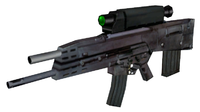
Throughout the development of Half-Life 2, its impressive arsenal of weaponry varied considerably, and it contained several different weapons than when the game was first made public, weapons that were later cut before the final release.
It has been suggested that the bulk of the weapons were cut due to the fact that they were too similar to one another, as the AK-47 served a very similar role to the AR2, and the OICW the same to the SMG1, and that it would not be very believable to hold more than 25 weapons, even though a limited weapons system was implemented at some point, having the player throw a weapon before picking up a new one.[13]
Most, if not all of these weapons are usable in the playable leak and the mod Missing Information, although sometimes with some changes.
Characters
Combine
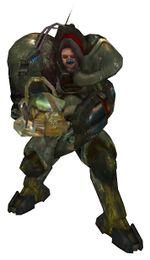
- Early drafts of the Combine soldiers were to make them look distinctively alien, but this was dropped when Valve wanted "a more transparent enemy".
- Originally, the Combine were to recycle human building materials for their own purposes. This resulted in somewhat odd designs, such as the Citadel's interior being made out of ceramic tiles.
- One of the sound files for two Metrocops walking through the Skyscraper (sound\vo\sky in the Beta) indicates that Combine-developed weaponry could only be used by those with "a messed up nervous system" and that non-standard issue weapons for Metrocops (such as Rocket Launchers) would be confiscated if not approved by Dr. Breen (at this point of development the Consul).
Monsters
- Tripod Hopper.
- The Particle Storm.
- The Combine Assassin.
- The Alien Assassin.
- The Bullsquid.
- The Houndeye.
- The Cremator.
- The Hydra.
- The Synth Combine Guard.
Citizens
- Originally, citizens were supposed to wear gas masks because of the Air Exchange making the air poisonous. This was dropped at the same time as the AirEx.
- There were to be child and adult workers at the factory section of City 17.
- During the Street War, there was to be a special type of Citizen that would give the player ammo. The only proof of his existence is a texture sheet in the 2003 leak.
Major Characters
- Alyx's father was originally a white man named Captain Vance. He was the head of security in the AirEx, and was to start the fighting that would ultimately destroy it.
- Eli used to have no relation with Alyx, though they were to be very close. Instead, he was an eccentric old man living in a scrapyard. Depending on the concept art, he can either be seen giving Gordon his HEV Suit or the Gravity Gun.
- In early drafts, Eli lost his leg while trying to examine a Particle Storm.
- Captain Vance and Eli were merged to create the Eli seen in the final version.
- Alyx originally wore a futuristic jumpsuit and a green jacket, but this was scrapped a short time before the E3 demos were shown.
Locations
- City 17
- Wasteland
- Depot
- Air Exchange
- Borealis
- Kraken Base
- Weather Control
- Skyscraper (also known as Vertigo)
- Street Wars
- Citadel
Vehicles
- AirEx Truck (as a static prop)
- Digger
- Jet Ski
- Israeli Merkava (used by the conscripts)
- VAB APC (also used by the conscripts)
Fate of the cut material
Many of the cut concepts will never be reused. There are some exceptions, however, and some elements finally made their way into the released games.
Half-Life 2
- The Overwatch Elite gathering all of the elite units concepts, notably the Combine Super Soldier and the Combine Assassin.
- The Alien Assassin was recycled into the Fast Zombie.
- Ravenholm being originally located at the end of the canals and before Eli's lab, it featured a lake at its foot, with at least one Ichthyosaur. This lake and the small docks were somehow kept for Black Mesa East when the chapter orders was reversed, and for the only Ichthyosaur appearance during the teleportation failure at the start of Half-Life 2.
Lost Coast
Lost Coast was based on a chapter cut from Half-Life 2 and finally released as an HDR technology demo. However none of its material is in the leaked files.
Episode One

- The Air Exchange train wreck[2] was reused at the start of the chapter Lowlife.
- The huge destroyed concrete level at the start of Vertigo seem to have been re-used in the City 17 Underground in the chapter Lowlife, where Gordon and Alyx are fighting Antlions and Gordon must find cars to block the Antlion holes.
- The Stalkers, originally to be fought in Half-Life 2, are at last directly confronted in Episode One.
- The Citadel Core was to appear in Half-Life 2, since a prototype map exists in the WC mappack.
- The Advisor room. The tube used by Advisor pods to leave exists in a very old WC mappack map.
Episode Two
- The Air Exchange train wreck[2] was reused at the very start of the game, while at some point wrecked train cars in a valley were to be seen at the end of the Canals before Ravenholm, somehow recycled for the start of Episode Two.[3]
- The Antlion caves.
- The Antlion Grubs, that were to be met in those caves.
- The Antlion King, that was also to be met in those caves, recycled into the Antlion Guardian.
- Some mining themes cut from Ravenholm, such as carts, were reused for the Victory Mine area.
- The Synth Combine Guard AI was recycled for the Hunter.
Episode Three
- The Borealis will most likely be seen or visited, as the Aperture Science ship.
- Kraken Base, the Arctic base where Judith Mossman probably sent her message from, might also be visited, possibly under a different name. Helena Mossman was indeed stationed in Kraken Base in the early storyline.
Mods
Since the release of the retail game in 2004, many attempts have been made to restore the original storyline by making mods based on the leaked files. Some mods never went further than rough development stages and some fixes while some are still in development. Also, some players fixed several maps without including them in a full game. These can be found across the web.
One of the most famous mods based on the Beta, and actually the only to have ever been released, though in an unfinished state, is Missing Information. While originally considered "illegal content" by Valve, it has since been deemed legal as long as it is distributed for free as a mod and does not use the original source code. The mod's current version includes the E3 2003 presentation and an incomplete Borealis chapter.
Half-Life 2 demonstrations
Menu gallery
Very first Half-Life 2 menu background, dated 1998, when Half-Life 2 was still on GoldSrc. Of note are the American skyscrapers skyline in the back.
More recent menu background, featuring Gordon Freeman (based on that image).
- Console background1.png
Ditto, background only.
Other menu background, left out in the Dark Messiah of Might and Magic (a non-Valve game using the Source engine) texture files.
See also
See these related articles for more information on the early Half-Life 2:
References
- ↑ Marc Laidlaw Vault on the ValveTime.net Forums
- ↑ 2.0 2.1 2.2 2.3 Half-Life 2: Raising the Bar
- ↑ 3.0 3.1 3.2 WC mappack
- ↑ Half Life 2 Source-Code Leak Delays Debut. TechNewsWorld. Retrieved on February 14, 2007.
- ↑ Playable Version of Half-Life 2 Stolen. CNN Money. Retrieved on February 14, 2007.
- ↑ 'Phatbot' man linked with Half-Life 2 leak. play.tm. Retrieved on February 16, 2007.
- ↑ Valve and FBI faked interview to lure hacker to US on Geek.com
- ↑ Infosecurity 2008 Threat Analysis, page 16, ISBN 1597492248 ISBN 978-1597492249
- ↑ How Legal Codes Can Hinder Hacker Cases - WSJ.com. Online.wsj.com. Retrieved on 2008-09-21.
- ↑ http://wsjclassroom.com/archive/05feb/onln_hacker.htm Hacker Hitmen - Cyber Attacks Used to Be for Thrill Seekers. Now They're About Money.
- ↑ How Legal Codes Can Hinder Hacker Cases. Wall Street Journal Online. Retrieved on April 12, 2008.
- ↑ Playable Half-Life 2 leak files
- ↑
 Half-Life 2 at E3 2003: Coastline on YouTube
Half-Life 2 at E3 2003: Coastline on YouTube
External links
Misc.
- "I need the assistance of the community" - the original thread created by Gabe Newell on the Halflife2.net forums on October 3, 2003
- The Boy Who Stole Half-Life 2 - article about Axel Gembe on Eurogamer
- The Truth Behind The Half-Life 2 Robbery on Rock, Paper, Shotgun
Beta footage
 Half-Life 2 E3 2002 Trailer on YouTube
Half-Life 2 E3 2002 Trailer on YouTube First sight of the Source engine at E3 2003, part 1 on YouTube
First sight of the Source engine at E3 2003, part 1 on YouTube First sight of the Source engine at E3 2003, part 2 on YouTube
First sight of the Source engine at E3 2003, part 2 on YouTube Gameplay in various maps on YouTube
Gameplay in various maps on YouTube- Video of the original Kleiner's Lab sequence (test) for the Beta-based mod Dark Atmosphere on RuTube
Mods based on the development of Half-Life 2
- Team GabeN (part of Gabe's Love Tub, released but some works in progress left)
- The Axel Project (a rebuild of the Source Engine leaked in 2003, archived)
- Missing Information (released)
